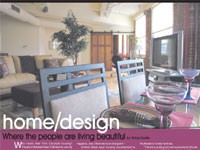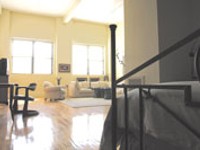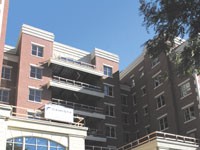Brian Short, site manager for the Temple Building, knows his building offers amenities beyond the new appliances and hi-tech security systems.
"There was a guy from Holland, and he's going to be here five years for work," Short says. "It was a Friday night. I said, 'Go put your car away and come back downtown tonight.' It was one of the East End Fests. Then I saw him about two weeks later when he decided this was where he wanted to be. I asked him, 'Did you make it down to see the East End Fest?' He said, 'I never made back to my hotel until 4 o'clock in the morning.'"
In contrast with that party-central attitude, the Temple Building actually began as an idea at a church committee meeting.
The 14-story neo-Gothic building was built in 1925 by a Baptist congregation: Along with 200-plus rental offices and street-level retail space the building included four stories of office space for the church administration and a 1400-seat auditorium perfect for worship services. The rented space would provide income.
But in 1965 the Baptists decided the upkeep was too demanding and moved to Brighton. No wonder. The building is enormous. But with steel girders and a concrete, limestone, and brick skin, it's solid.
In 1999 Costanza Enterprises made a great decision not to tear it down. They recognized the potential in the architecture and gutted it instead. And after $5 million in renovations it reopened in 2003 with room for retail shops and restaurants, commercial space, and --- one of the currently most desirable sounds in the modern urban housing landscape --- loft apartments.
The Landmark Society's Katherine Comeau cites the Temple Building as an early example that helped inspire others.
"People see what can be done," she says, "and how well these buildings do adapt themselves to new use."
"Just imagine, where we are now, this was all commercial space," Short says. "The place was totally gutted. You've got the original brickwork of the building exposed, ceilings are all the original ceilings, but everything else is brand-spanking new."
"At one point there were over 50 dentists in the building," he says. But now there's no hint of unpleasantness inside. Residential living is on the second through seventh floors (only accessible with a resident's key or security code). The apartments feature a lot of the charming details that give reclaimed commercial space that bohemian, urban color: restored interior brick walls, limestone arches, and neo-gothic stone tracery (interlacing ribs). Add to that modern amenities --- WiFi wireless network, a cavernous basement rebuilt as a three-story parking garage, energy-efficient windows, hardwood floors, keyless access, and video intercoms --- and you've got the height of urban chic.
Speaking of height: The Temple Building uses an interesting idea for space in its seven work-live lofts, which have 25-foot ceilings ($1850 to $3275 a month). Most of these have one bedroom and one-and-a-half bathrooms, and they range in area from 1750 to 3175 square feet. The first floor has a kitchen, two big, open rooms, and one bathroom. An open metal staircase takes you to the loft and a hallway with bathroom, closets, and laundry hookup. Light from the huge windows and the exposed brick give the space a warm feel.
Standard lofts range from studio to two-bedroom apartments and have one or two bathrooms. These begin at 850 square feet and can be as large as 1700 square feet. (Rent is $900-$1800.) The penthouse lofts are as big as many suburban family homes: 1700 to 2100 square feet, two bedrooms, two full baths. But you pay for them at $1800 to $2200 per month.
Thirty-seven of the 40 apartments are rented, and one more application is working through the channels.
"A lot of people want to be downtown now," Short says. "You can walk right up East Avenue to clubs, restaurants, bars; the Eastman Theatre is within walking distance. They're talking about the Renaissance Square thing that's going to be literally right around the corner."
"To invest in downtown right now, if you can get in somewhere, would be a good thing."
Temple Building, 14 Franklin Street






